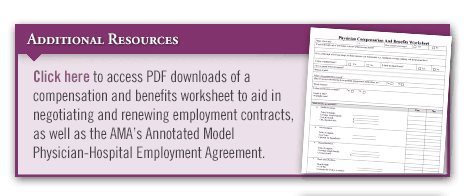Faced with declining reimbursement, added expenses from implementing new technologies, and countless other factors (Figure), research has shown that many physicians are fleeing private practice to pursue employment in hospital systems. Most hospital employment contracts offer a guaranteed salary for 1 to 3 years that is equal to a physician’s salary the previous year in private practice. For many, the decision appears to be a no-brainer. However, these employment contracts can be wrought with ambiguous clauses that can leave physicians wishing they had taken a closer look before signing on the dotted line.
Becoming Vigilant of Ambiguity in Contracts
Employment contracts usually have guaranteed compensation for some period, according to Dennis Hursh, Esq. “Once that period ends, compensation is often based purely on productivity,” he says. “Physicians then have all the disadvantages of private practice—including declining reimbursement—but they’re not their own boss and don’t have the flexibility in schedule that comes with private practice. Productivity formulas can be so nebulous that they’re almost impossible to quantify. In addition, many agreements allow for periodic unilateral changes in the compensation formula.”
One of the biggest issues with physician employment contracts occurs at termination, explains Hursh. “It’s important for physicians to know if their contract includes a covenant not to compete once the contract expires, meaning they won’t be allowed to practice anywhere within a given area or at specific facilities. The ramifications of such clauses are profound. In some cases, physicians who leave their job may need to pull their children out of school and start a new practice in a different location.”
As the financial strings continue to tighten, many physicians have turned to moonlighting. For example, they provide peer review, credentialing, and/or other medicine-related services. Some hospitals, however, will not allow any outside professional services in their employment contracts.
The location of services is another important aspect of employment contracts. “Some healthcare systems have facilities that are spread out over many miles,” notes Hursh. “The contracts stipulate that the physician will work wherever he or she is assigned. The physician may think they’re going to be working at the hospital in town, but could end up being assigned to a clinic 20 miles away.”
Ambiguity is the overriding theme to nearly all “threats” in employment contracts, according to Hursh. “Physicians often believe they know what their contracts provide when they sign them. However, their employer can assert a different interpretation. When a dispute arises, the physician will go back and review the contract they signed, only to see that the contract could be interpreted the way their employer claims.”
Making Changes to a Hospital Contract
According to Hursh, a physician’s best chance of making changes to a contract is to be aware of all potential issues and bring them up when negotiating the contract. However, if the agreement has already been signed, there is still a chance to fix problems when the time comes to renew a contract. “This is when ambiguity can be eliminated,” says Hursh. “For example, instead of a covenant not to compete stating that the physician cannot work at ‘competing hospitals,’ the language could be changed to set forth the specific hospitals where the physician cannot work. These contracts are not carved in stone.”
“Physicians often believe they know what their contracts provide when they sign it. However, their employer can assert a different interpretation.
During the hiring and contract renewal processes, hospital administrators often say that physicians are receiving an “unchangeable, standard contract,” but Hursh says it is extremely rare for this to actually be the case, even with major health systems. “In most cases, physicians who wish to change specifics of their contract can get these changes made, as long as they are within reason.”
The American College of Physicians has created a compensation and benefits worksheet to assist physicians in ensuring that all bases are covered when reviewing contracts (see “Additional Resources” link above.). Hursh notes that physicians should make every effort to understand and recognize the effects of their contract. “It’s important to set goals for what you want to achieve, be it a certain lifestyle, a specific salary, or something else. You need to dissect your contract and make sure there are no loopholes. In many scenarios, attorneys can be a great asset to help physicians sort through the ambiguity.”




 admin
admin